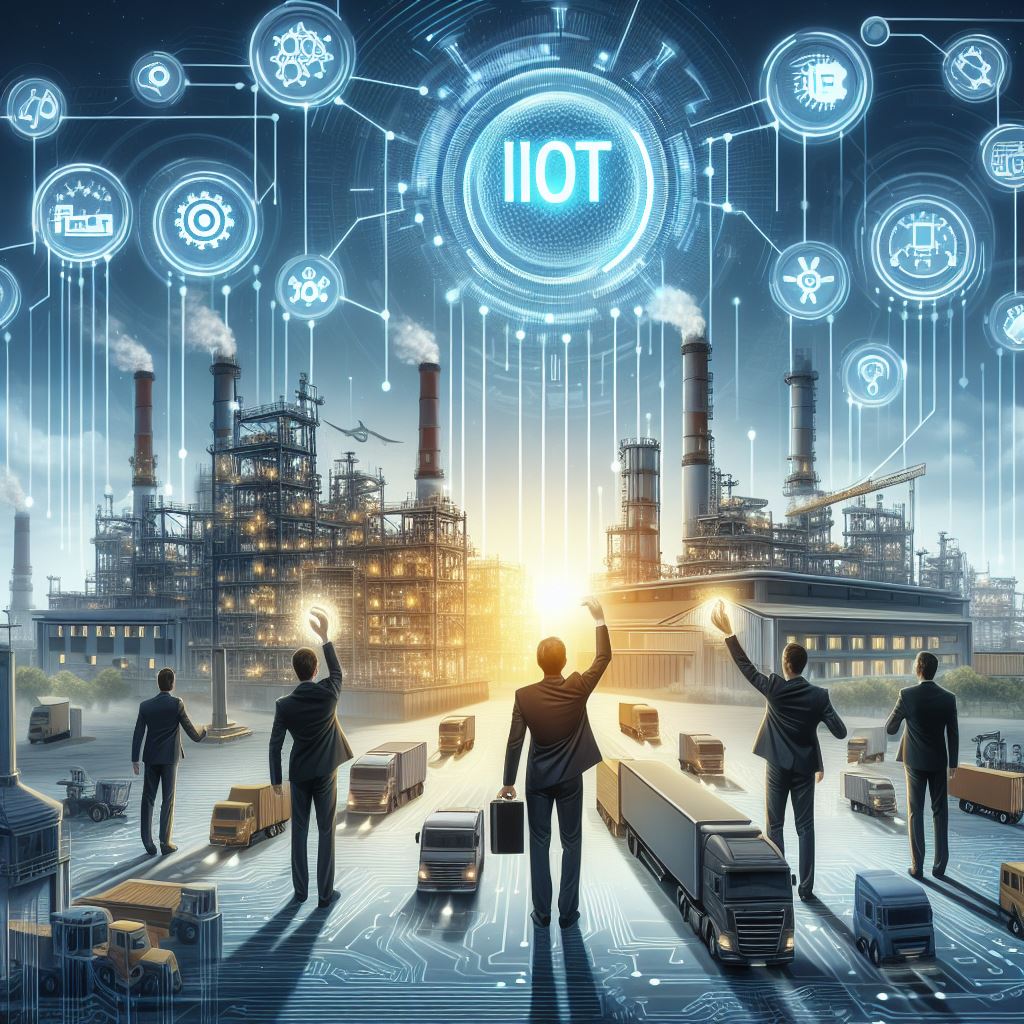The global industry 4.0 market size is expected to touch USD 165.5 billion by 2026 at a compound annual growth rate (CAGR) of 20.6%. India is also keen on adopting Industry 4.0 and is actively taking multiple initiatives.
In fact, the Indian government has planned to increase the contribution of the manufacturing sector to 25% of the gross domestic product by 2025.
This means Industry 4.0 has a shining future on both local and international grounds.
Sterison’s smart factory IoT solutions have empowered businesses to adopt the digital transformation. With real-time monitoring, predictive maintenance, and other data-driven insights, it not only optimizes operations but also cuts down on downtime and costs.
This article will explain the factors to check while hiring an IIoT solution provider and the Industry 4.0 technologies offered by Sterison.
What is an IoT smart factory?
An IoT smart factory is an interconnected network of three things: machines, sensors, and systems that are interconnected through a network infrastructure and allow quick and easy communication and data exchange. By sharing data and leveraging machine learning and AI, they can make autonomous decisions. When a manufacturing unit has this level of interconnectivity and automation, it promotes a more flexible and efficient production process.
What are the Industry 4.0 technologies offered by Sterison?
IoT Devices and Sensors
Earlier, manufacturers in industrial settings had to wrestle with multiple challenges to thrive in a competitive landscape.
Some challenges include:
- Operational inefficiencies due to mundane tasks, manual interventions, and a lack of real-time insights.
- Limited visibility leads to the problem of having a holistic view of the production process.
- Unplanned equipment downtime and maintenance resulted in unavoidable disruptions.
Other issues include quality control and scalability hurdles.
Here’s how IoT devices and sensors solved these issues in one go:
IoT devices main work is to generate vast amounts of data through sensors, actuators, and connected systems. So, a factory integrated with IoT-enabled devices and sensors communicates with each other and shares data. This way, you can gather real-time data on equipment status, inventory levels, production rates, etc.
Here, IoT technology embeds intelligence, connectivity, and data-driven decision-making into all these manufacturing processes.
How?
IoT-enabled sensors gather real-time data from machinery and equipment and predict maintenance needs accurately.
Also, it enables data-driven decision-making that leads to optimized manufacturing processes, reduced waste, and improved overall efficiency.
Since it can detect defects and deviations instantly, it ensures you produce only high-quality products.
Overall, Sterison’s IoT devices and sensors benefit manufacturers with reduced downtime,costs, extended equipment lifespans, and enhanced safety. The best part? It allows for a data-driven decision for optimization and resource allocation.
Big Data Analytics
Big data analytics refers to the process of collecting, processing, and deriving insights from vast amounts of data to make data-driven decisions and model the data to make informed decisions to improve processes and optimization. In an industrial setup, big data analytics helps monitor and control the production process and thus achieve optimal efficiency.
Big Data analytics is essential to Industry 4.0 because it plays a big role in making artificial intelligence and machine learning possible.
It enables real-time monitoring of equipment performance, production processes, and supply chain operations. It processes and analyzes the collected data and helps optimize performance in manufacturing processes.
Also, by analyzing large volumes of data from both internal and external sources, organizations can detect security breaches and ensure compliance with regulatory requirements.
Sterison’s AI big data analytics features are:
- Offers effective human-computer interaction
- Let’s take price, promotions, and other business decisions.
- Find unknown factors impacting demand.
- Locate the local events and other external factors impacting sales.
Check out more on what Sterison can offer here.
Cloud and edge computing
Edge computing refers to a distributed computing framework with a range of networks and devices placed at or near the user. In an industrial setup, edge is about processing data closer to where it’s being generated, which enables processing at greater speeds and volumes. This leads to better results in real time.
So, it reduces latency, improves response time, and saves bandwidth by processing data locally or near the source where it’s generated.
On the other hand, cloud computing offers scalability, flexibility, and advanced analytics capabilities to store and analyze large volumes of data. So, they can easily run complex algorithms.
Now that cloud and edge computing are combined, they improve the efficiency of Industry 4.0.
How?
In an industrial setup, edge computing handles immediate processing needs. Meanwhile, cloud computing handles larger-scale analytics, storage, and long-term insights.
So, Sterison’s Industry 4.0 solution paves the way for smarter, more connected, and more efficient industrial processes that enhance the strengths of both cloud and edge computing.
AI and machine learning
Machine learning, a subset of AI, allows machines to carry out tasks effectively without human intervention.
AI and machine learning can predict when a breakdown might happen in your machines by analyzing data. So, companies can quickly repair and maintain equipment and avoid costly downtime.
Manufacturers can analyze data from production lines and identify if there are any issues with the products or processes in real time. Because nobody would want to deliver damaged or faulty goods to their customers.
The best part? AI and machine learning algorithms can easily analyze market trends,
past sales data and other factors to accurately predict future demand. So, companies can optimize their inventory and production schedules better.
Keeping track of everything in a supply chain has always been a big headache. Here, AI and machine learning can easily optimize logistics, predict delivery times, and detect potential issues before they happen. This allows the supply chain to run smoothly.
Key Considerations in Choosing an IIoT Solution Provider
You may ask why I go for an IIoT solution provider and not an IIoT platform.
It’s because many of these platforms fail to represent the entire set of services required to support an organization in building an IIoT business solution. They lack a customized approach because every IIoT platform must be configured, modified, and integrated with back-end systems and data to meet the requirements of the IIoT project or deployment.
This is a complex process and the customization process itself will cost you a lot. This is why it’s best to choose an end-to-end IIoT solution provider.
Here are some factors to consider while choosing an IIoT solution provider:
Scalability
With time, your organization will grow. So, when the number of devices and data volumes increases in your manufacturing unit, the IIoT system must grow along with the changes. So, check if the Industry 4.0 IIoT solution provider can design a flexible architecture that enables easy expansion and integration of new devices and technologies.
And check how they are scalable. Do they leverage cloud computing platforms like Google Cloud, Azure, and AWS that have inherent scalability?
How do they handle the growth of the influx of data generated by IIoT devices?
Security and data privacy
You can never take chances on security. Since there will be an end-to-end connection and communication, potential security challenges pose a threat.
And remember that security is an ongoing process that demands constant evaluation and adaptation to address evolving threats and technologies.
So, check if the IIoT provider can deliver robust security measures throughout the system. It’s best that the IIoT systems use secure communication protocols such as HTTPS, MQTT with TLS/SSL and other industry-standard encryption methods.
To restrict unauthorized interactions with IIoT devices and systems within your manufacturing units, a strong access control mechanism with robust password policies, role-based access, and multi-factor authentication must be implemented.
Lastly, ask if the provider will keep all the IIoT devices and software up to date with the latest security updates.
Customization and tailored solutions
Every industry and business has its own set of needs. So, your industry IoT solution provider must tailor their solution to fit your needs and challenges. Because one size does not fit all in IIoT. For example, the experts at Sterison, a robust IIoT provider, study the organization’s processes to further design, develop, and implement mature and flexible industrial IOT solutions. They dive in deep based on detailed requirements to provide a solution that satisfies the client’s needs.
Check how they handle connectivity management
First, know what kind of connectivity requirements you have and check if your existing system, let’s say your wifi, will be sufficient for the new one.
Will you need an IIoT solution that requires data processing at the edge? If so, consider local connectivity solutions, bandwidth requirements, and how you will split tasks between the edge and the cloud.
Reliability and performance
Check how reliable the IIoT solution providers are. Reliability and performance must not be overlooked because downtime and glitches can be costly in industrial settings. So, you must ensure that the IIoT solution is reliable and can perform well under any conditions.
Are you looking for a reliable industrial IoT to transition every part of your segment in the supply and production chain?
Get in touch with Sterison for a quick consultation. Our consulting services help assess the problem and understand how to enhance efficiency via technology-enabled business processes.






